Deep-Learning-Based Real-Time Road Traffic Prediction Using Long-Term Evolution Access Data
Abstract
1. Introduction
2. Related Works
3. Correlation Analysis of LTE Access Data and Traffic Information
4. Deep-Learning-Based Real-Time Road Traffic Prediction System Using LTE Access Data Preprocessing
4.1. Configuration of the System
4.2. Data Collector
4.3. LTE Data Preprocessing
4.3.1. LTE Access Frequency-Based Filtering
4.3.2. Filtering by Radio Resource Control (RRC) Link Classification of S1AP
4.3.3. Filtering by QoS Class Index (QCI) Packets Under S1AP
4.4. Road Traffic Speed Prediction Deep Learning Model
5. Experimental Results and Analysis
5.1. Performance Evaluation Metric
5.2. Performance Analysis of the Suggested Deep Learning Model
5.3. Analysis of Road Traffic Speed Predictions in Areas with Different Traffic Flows
6. Conclusions
Author Contributions
Funding
Conflicts of Interest
References
- Smith, B.L.; Pack, M.L.; Lovell, D.J.; Sermons, M.W. Transportation management applications of anonymous mobile call sampling. In Proceedings of the ITS America 11th Annual Meeting and Exposition, ITS: Connecting the Americas Intelligent Transportation Society of America (ITS America), Miami, FL, USA, 4–7 June 2001. [Google Scholar]
- Ygnace, J.L. Travel Time/Speed Estimates on the French Rhone Corridor Network Using Cellular Phones as Probes; Final Report of the SERTI V Program; INRETS: Lyon, France, 2001. [Google Scholar]
- Ygnace, J.L.; Drane, C. Cellular telecommunication and transportation convergence: A case study of a research conducted in California and in France on cellular positioning techniques and transportation issues. In Proceedings of the IEEE Intelligent Transportation Systems, Oakland, CA, USA, 25–29 August 2001; pp. 16–22. [Google Scholar]
- Caceres, N.; Wideberg, J.P.; Benitez, F.G. Review of traffic data estimations extracted from cellular networks. IET Intell. Transp. Syst. 2008, 2, 179–192. [Google Scholar] [CrossRef]
- Smith, B. Wireless Location Technology-Based Traffic Monitoring Demonstration and Evaluation Project—Final Evaluation Report; Smart Travel Laboratory Center for Transportation Studies University of Virginia: Charlottesville, VA, USA, 2006. [Google Scholar]
- Yim, Y.B.; Cayford, R. Investigation of Vehicles as Probes Using Global Positioning System and Cellular Phone Tracking: Field Operational Test; California PATH Working Paper UCB-ITS-PWP-2001-9; Institute of Transporation Studies, University of California: Berkeley, CA, USA, 2001. [Google Scholar]
- Fontaine, M.D.; Yakkala, A.P.; Smith, B.L.; McGhee, C.C. Probe Sampling Strategies for Traffic Monitoring Systems Based on Wireless Location Technology; Virginia Transportation Research Council: Charlottesville, VA, USA, 2007. [Google Scholar]
- Pattara-Atikom, W.; Peachavanish, R. Estimating road traffic congestion from cell dwell time using neural network. In Proceedings of the IEEE International Conference on ITS Telecommunications, Sophia Antipolis, France, 6–8 June 2007; pp. 1–6. [Google Scholar]
- Pattara-Atikom, W.; Peachavanish, R.; Luckana, R. Estimating road traffic congestion using cell dwell time with simple threshold and fuzzy logic techniques. In Proceedings of the IEEE Intelligent Transportation Systems, Seattle, WA, USA, 30 September–3 October 2007; pp. 956–961. [Google Scholar]
- Hansapalangkul, T.; Keeratiwintakorn, P.; Pattara-Atikom, W. Detection and estimation of road congestion using cellular phones. In Proceedings of the IEEE International Conference on ITS Telecommunications, Sophia Antipolis, France, 6–8 June 2007; pp. 143–146. [Google Scholar]
- Hongsakham, W.; Pattara-Atikom, W.; Peachavanish, R. Estimating road traffic congestion from cellular handoff information using cell-based neural networks and K-means clustering. In Proceedings of the IEEE International Conference on Electrical Engineering/Electronics Computer, Telecommunications and Information Technology, Krabi, Thailand, 14–17 May 2008; Volume 1, pp. 13–16. [Google Scholar]
- Chandrasekaran, G.; Vu, T.; Varshavsky, A.; Gruteser, M.; Martin, R.P.; Yang, J.; Chen, Y. Vehicular speed estimation using received signal strength from mobile phones. In Proceedings of the ACM International Conference on Ubiquitous Computing, Copenhagen, Denmark, 26–29 September 2010; pp. 237–240. [Google Scholar]
- Chandrasekaran, G.; Vu, T.; Varshavsky, A.; Gruteser, M.; Martin, R.P.; Yang, J.; Chen, Y. Tracking vehicular speed variations by warping mobile phone signal strengths. In Proceedings of the IEEE International Conference on Pervasive Computing and Communications (PerCom), Seattle, WA, USA, 21–25 March 2011; pp. 213–221. [Google Scholar]
- Thiessenhusen, K.U.; Schafer, R.P.; Lang, T. Traffic Data from Cell Phones: A Comparison with Loops and Probe Vehicle Data; Institute of Transport Research, German Aerospace Center: Berlin, Germany, 2003. [Google Scholar]
- Rutten, B.; Van Der List, M.; De Wolff, P. GSM as the source for traffic information. In Proceedings of the European Transport Conference (ETC), Strasbourg, France, 4–6 October 2004. [Google Scholar]
- Maerivoet, S.; Logghe, S. Validation of travel times based on cellular floating vehicle data. In Proceedings of the European Congress and Exhibition on Intelligent Transport Systems and Services, Aalborg, Denmark, 18–20 June 2007; pp. 18–20. [Google Scholar]
- Bar-Gera, H. Evaluation of a cellular phone-based system for measurements of traffic speeds and travel times: A case study from Israel. Transp. Res. Part C Emerg. 2007, 15, 380–391. [Google Scholar] [CrossRef]
- Liu, H.X.; Danczyk, A.; Brewer, R.; Starr, R. Evaluation of cell phone traffic data in Minnesota. Transp. Res. Rec. 2008, 2086, 1–7. [Google Scholar] [CrossRef]
- Gundlegård, D.; Karlsson, J.M. Handover location accuracy for travel time estimation in GSM and UMTS. IET Intell. Transp. Syst. 2009, 3, 87–94. [Google Scholar] [CrossRef]
- Dong, H.; Man, J.; Jia, L.; Wang, X.; Qin, Y.; Liu, K. Traffic speed estimation using mobile phone location data based on longest common subsequence. In Proceedings of the IEEE International Conference on Intelligent Transportation Systems (ITSC), Maui, HI, USA, 4–7 November 2018; pp. 2819–2824. [Google Scholar]
- Greenshields, B.D.; Channing, W.; Miller, H. A study of traffic capacity. In Highway Research Board Proceedings; National Research Council (USA), Highway Research Board: Washington, DC, USA, 1935. [Google Scholar]
- Topis. Available online: https://topis.seoul.go.kr (accessed on 2 December 2019).
- Smith, B.L.; Williams, B.M.; Oswald, R.K. Comparison of parametric and nonparametric models for traffic flow forecasting. Transp. Res. Part C Emerg. 2002, 10, 303–321. [Google Scholar] [CrossRef]
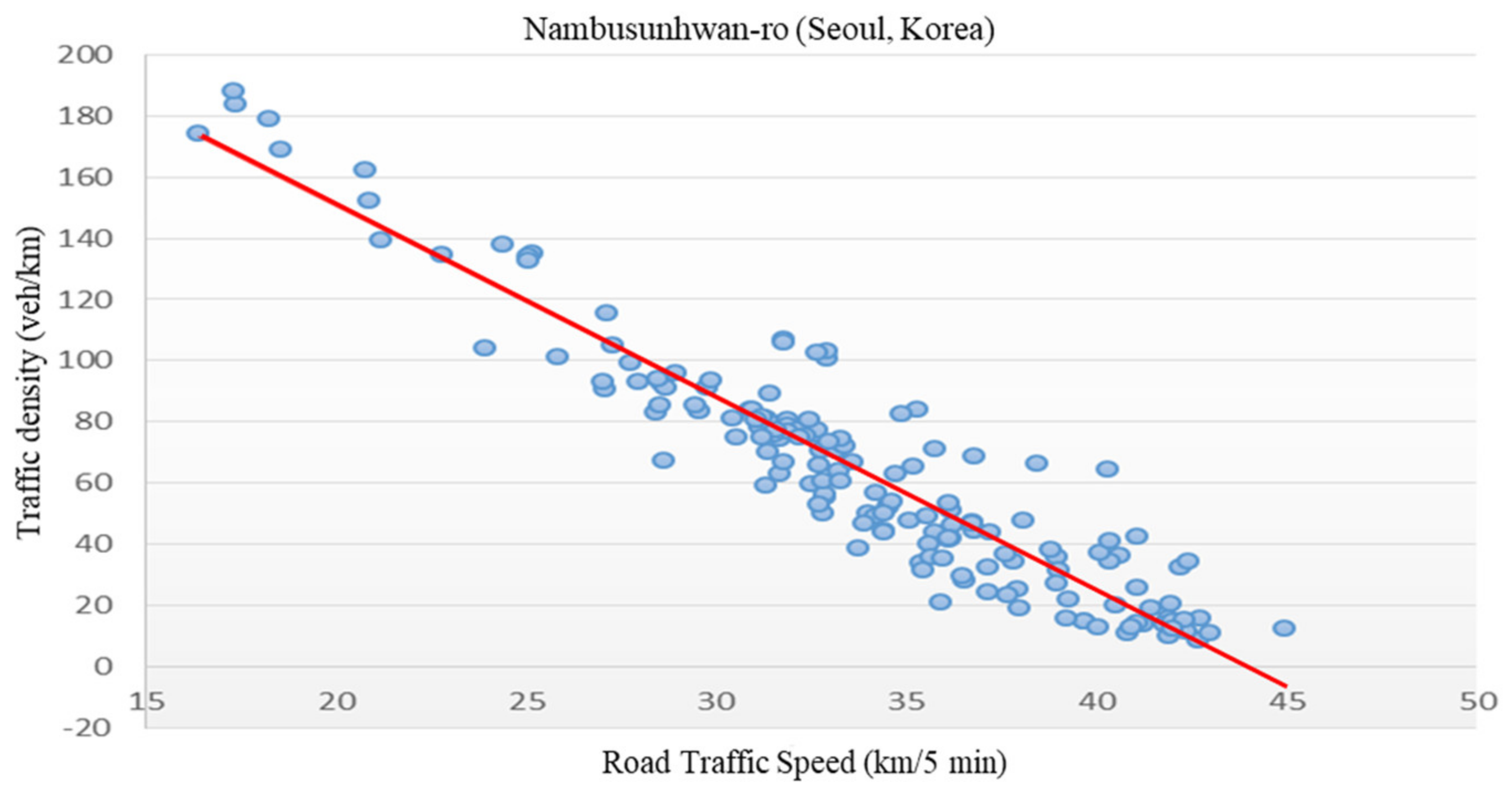
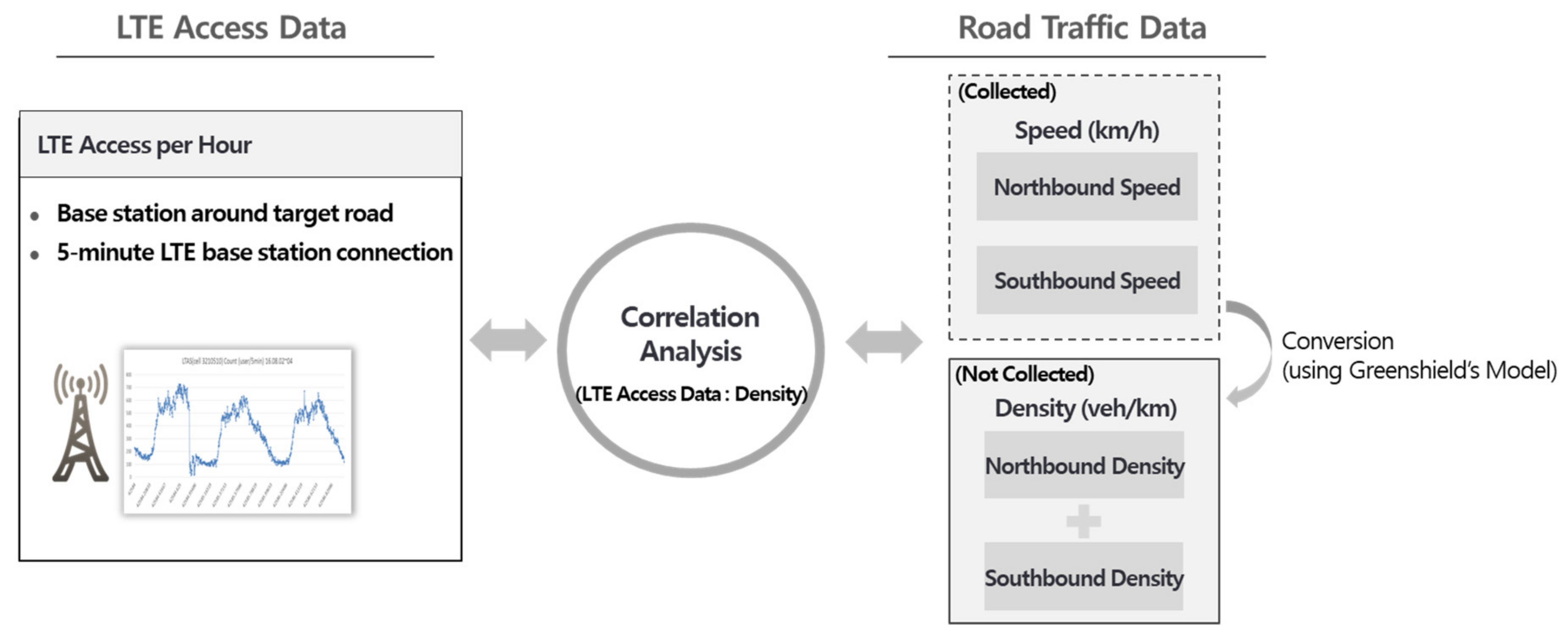

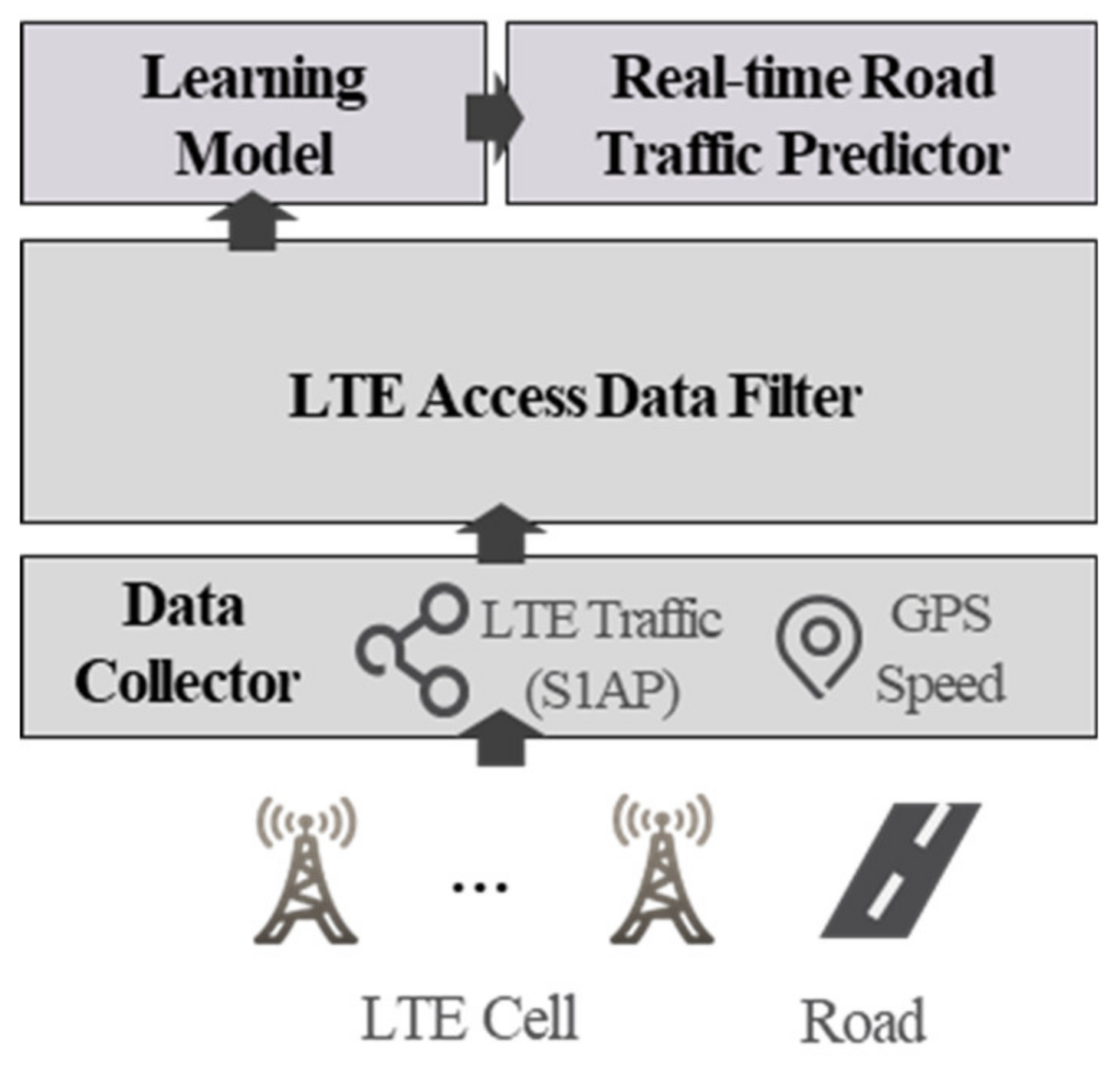
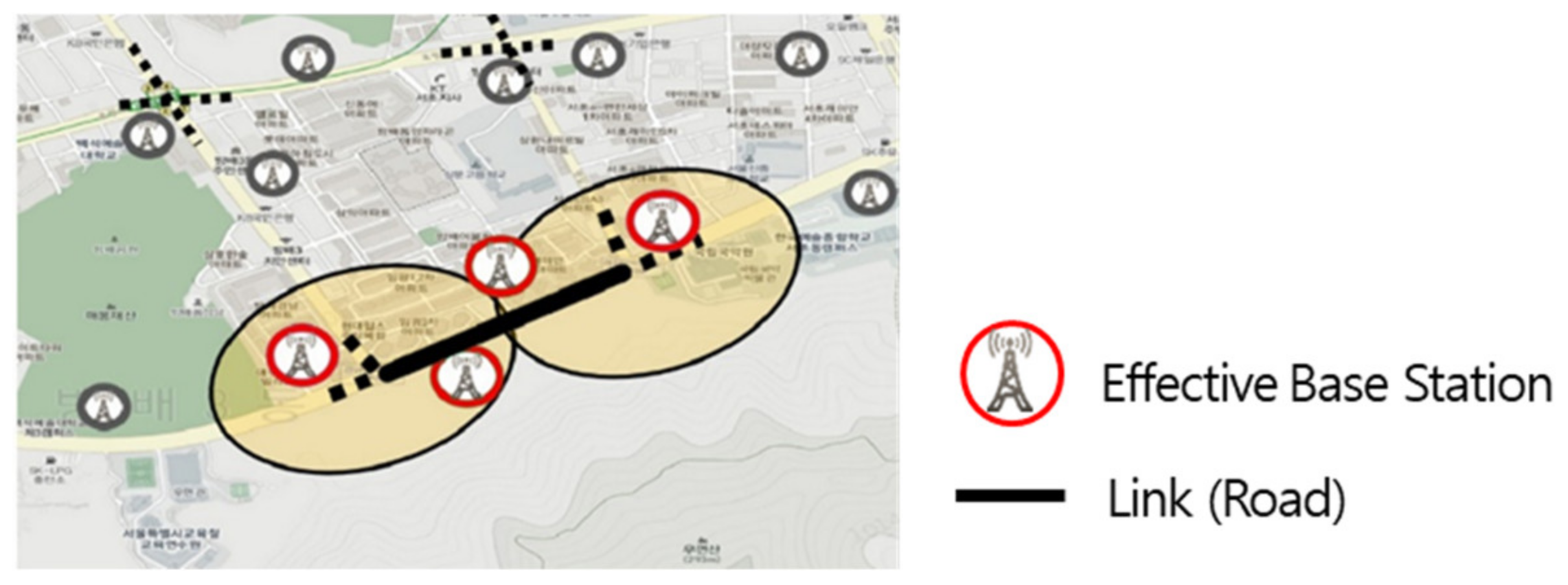
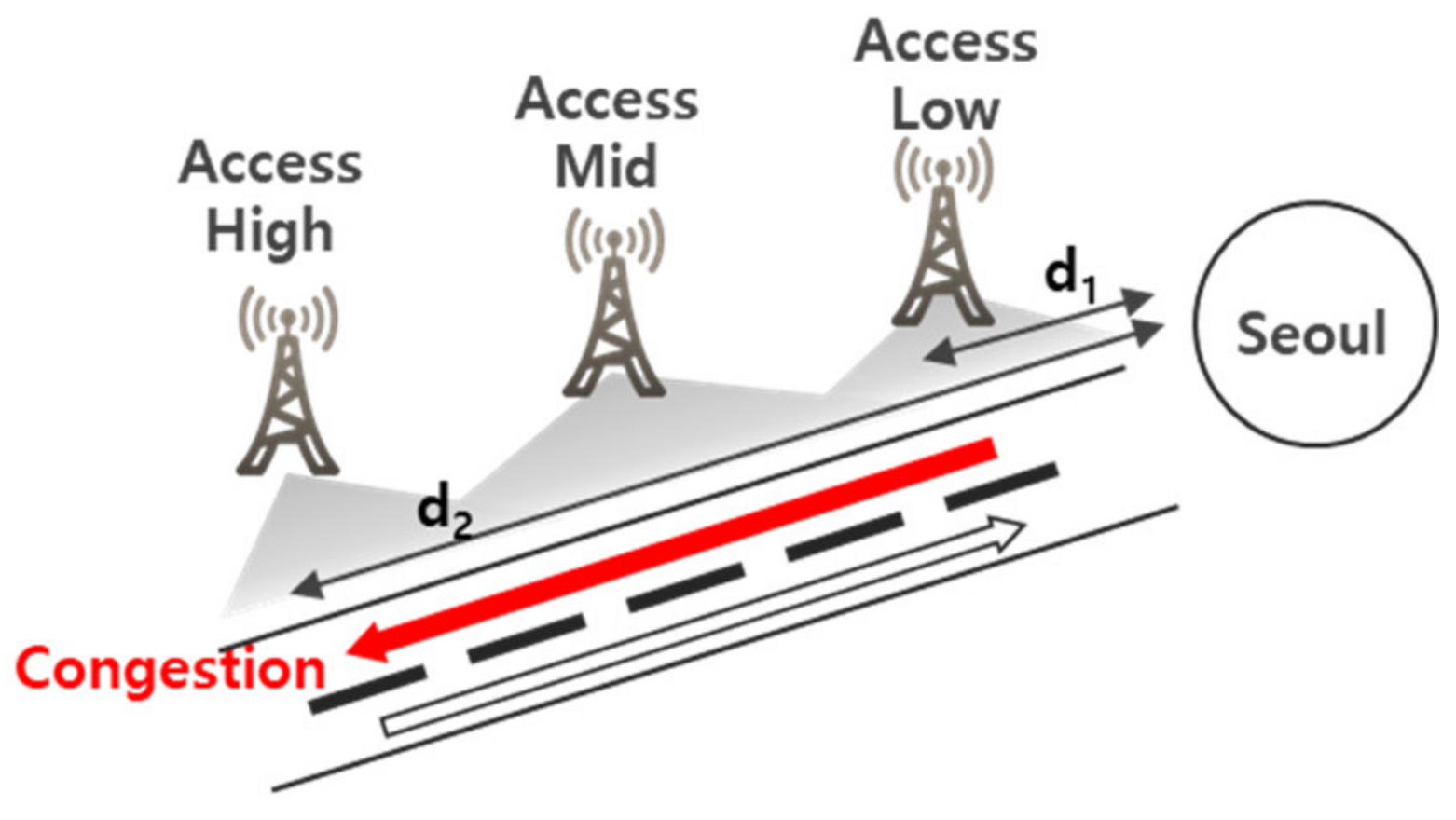


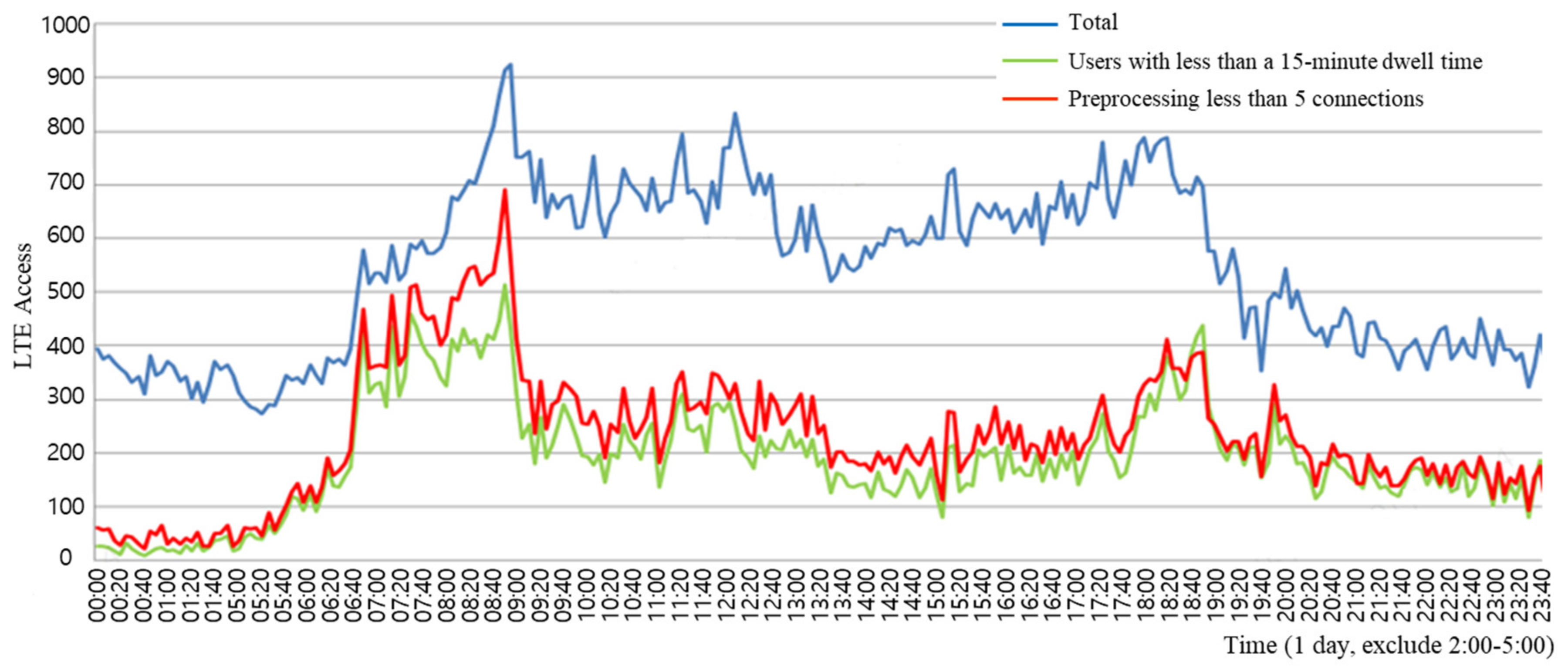
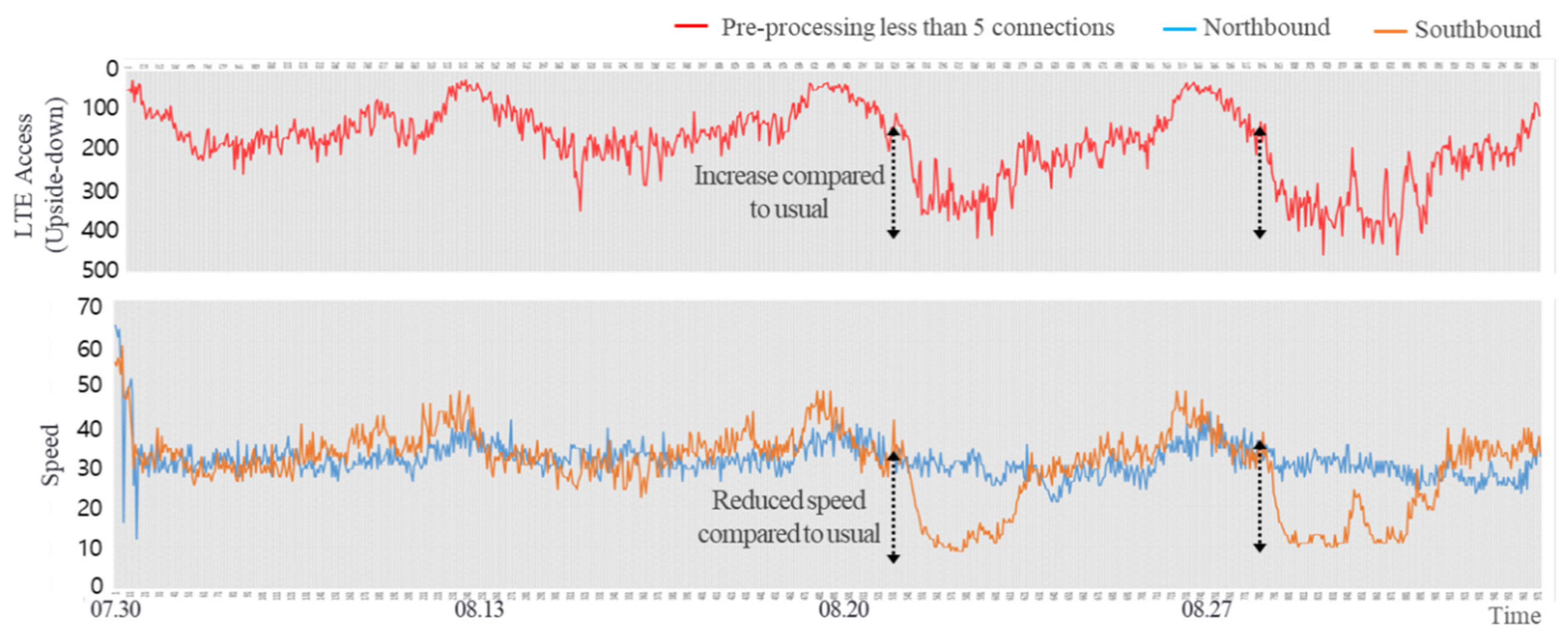


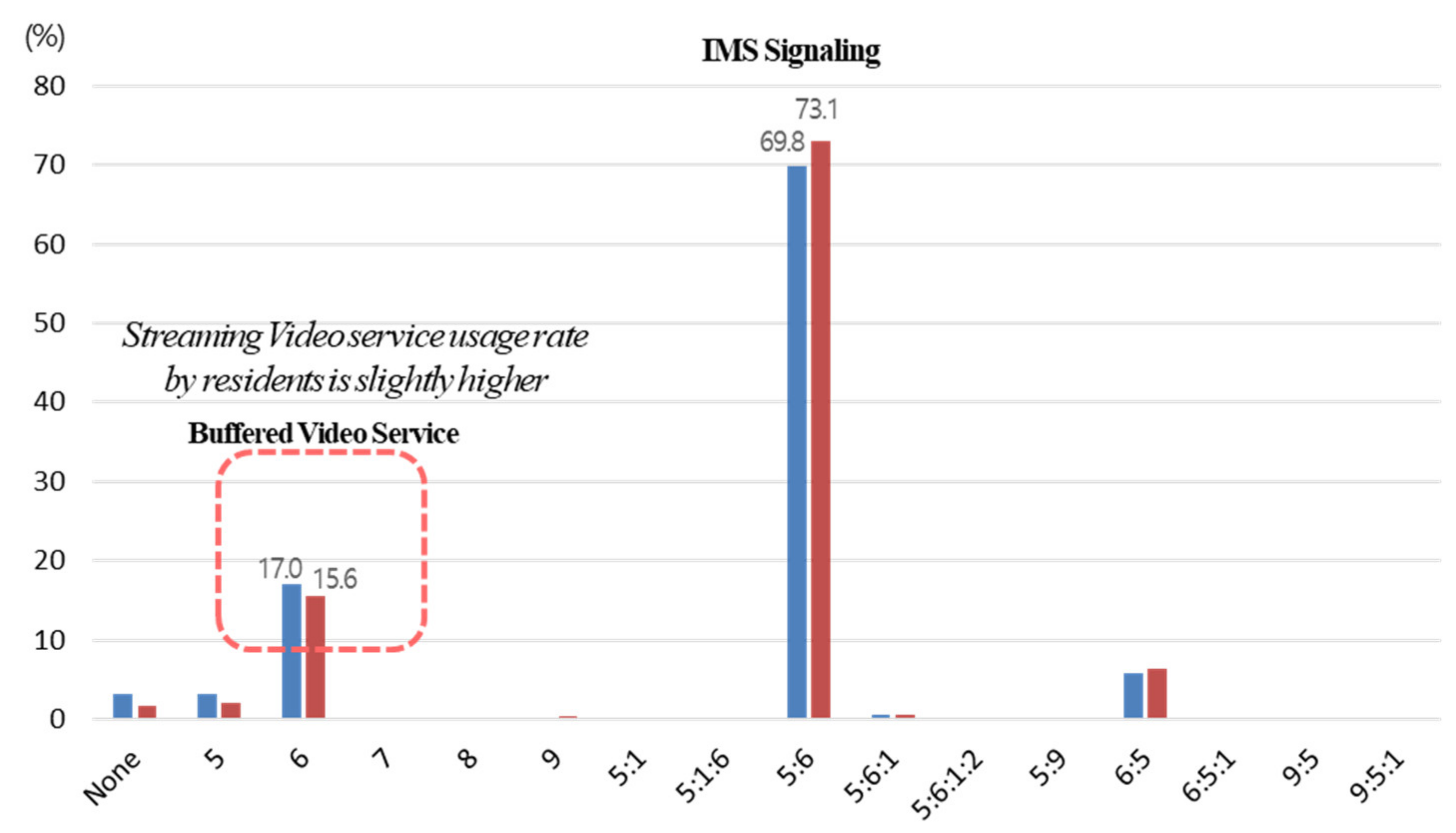
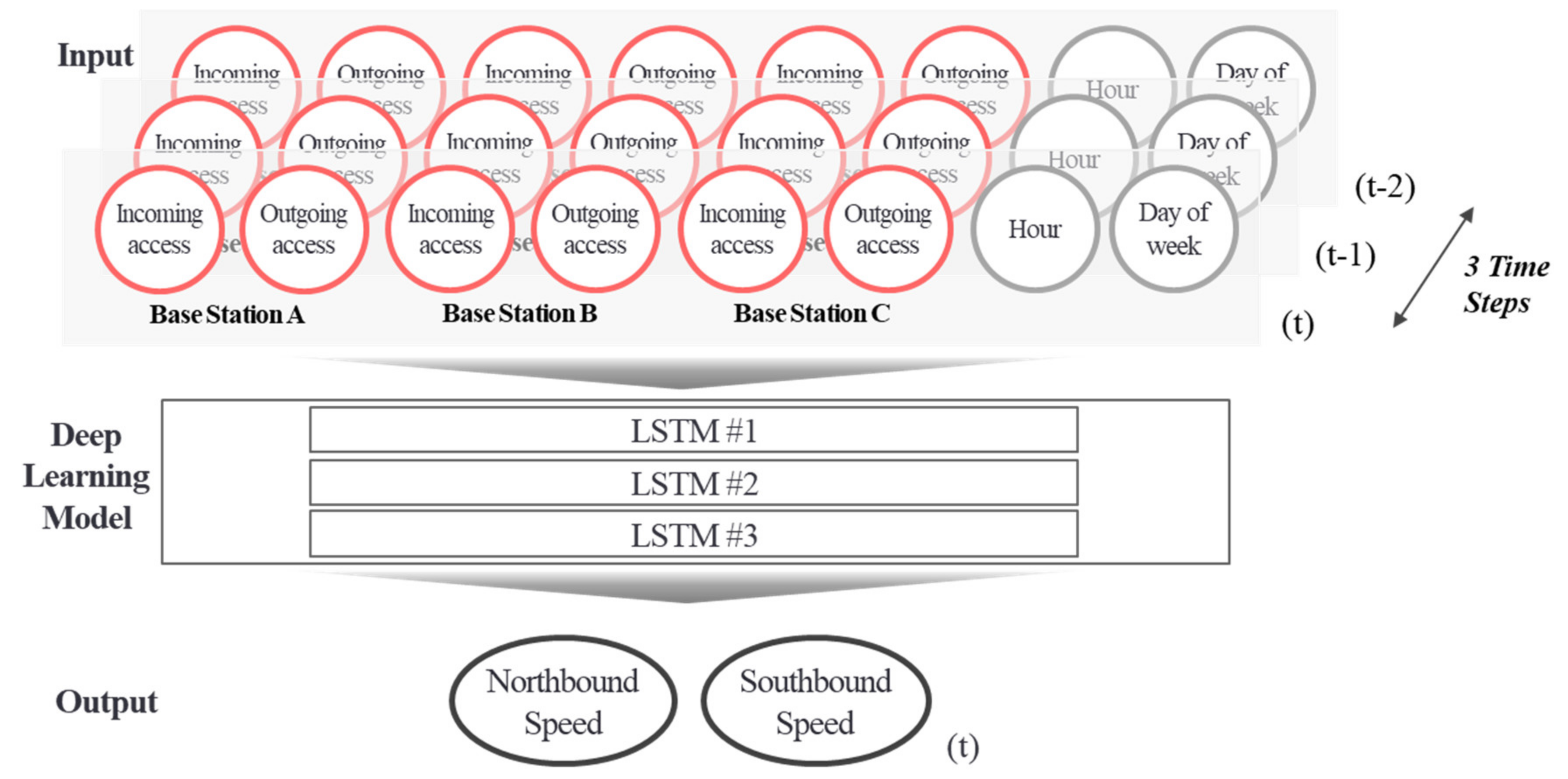
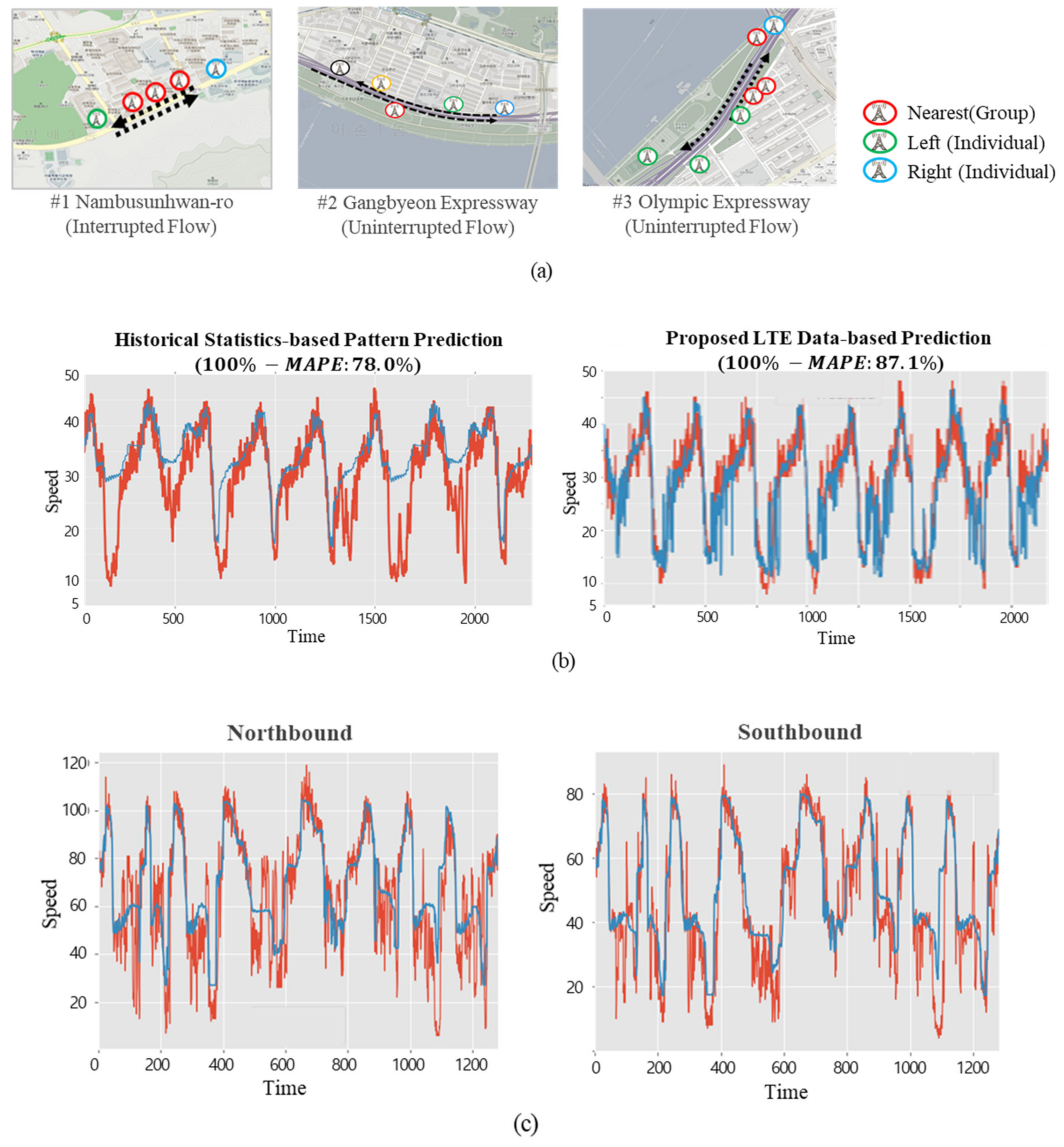
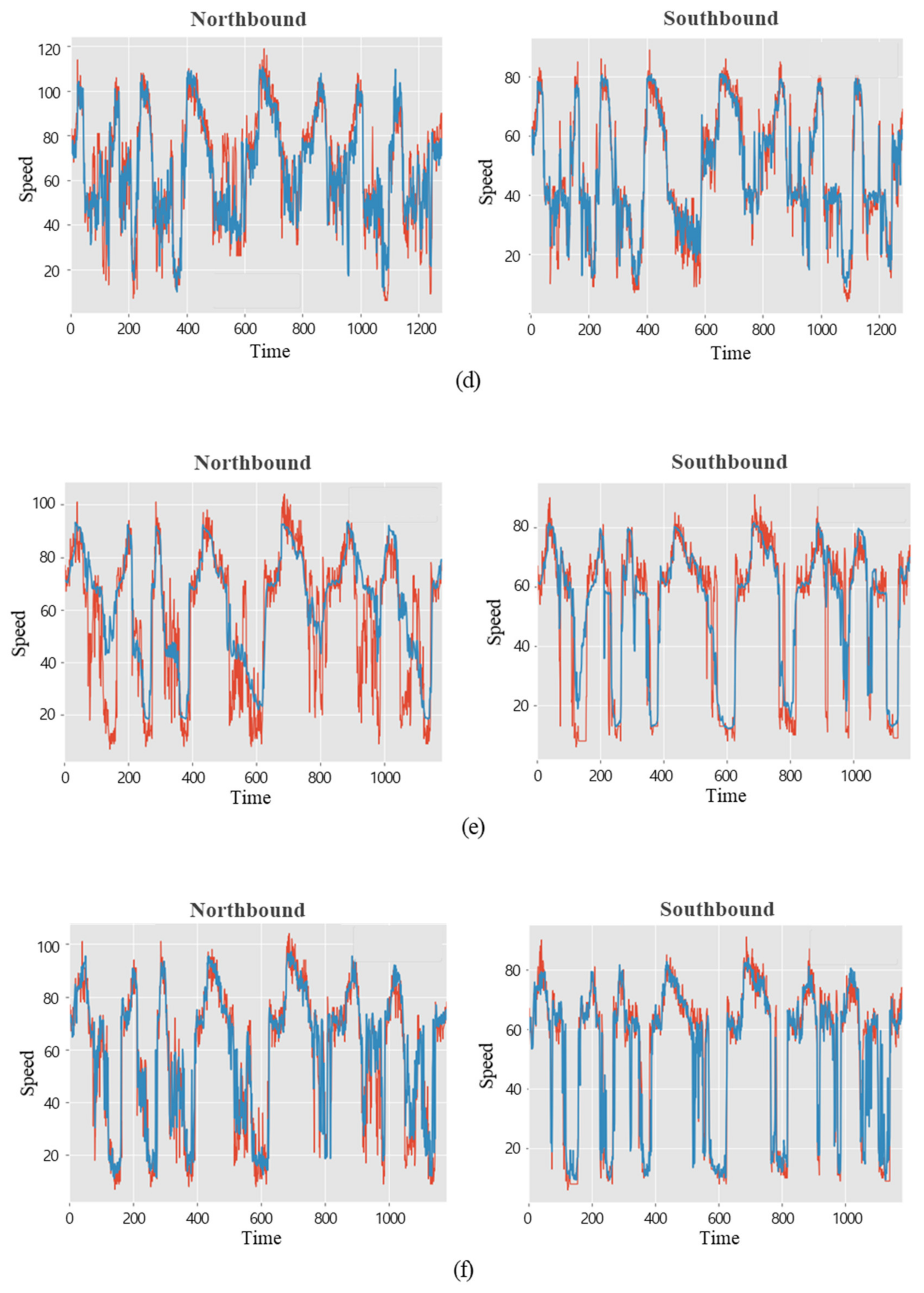
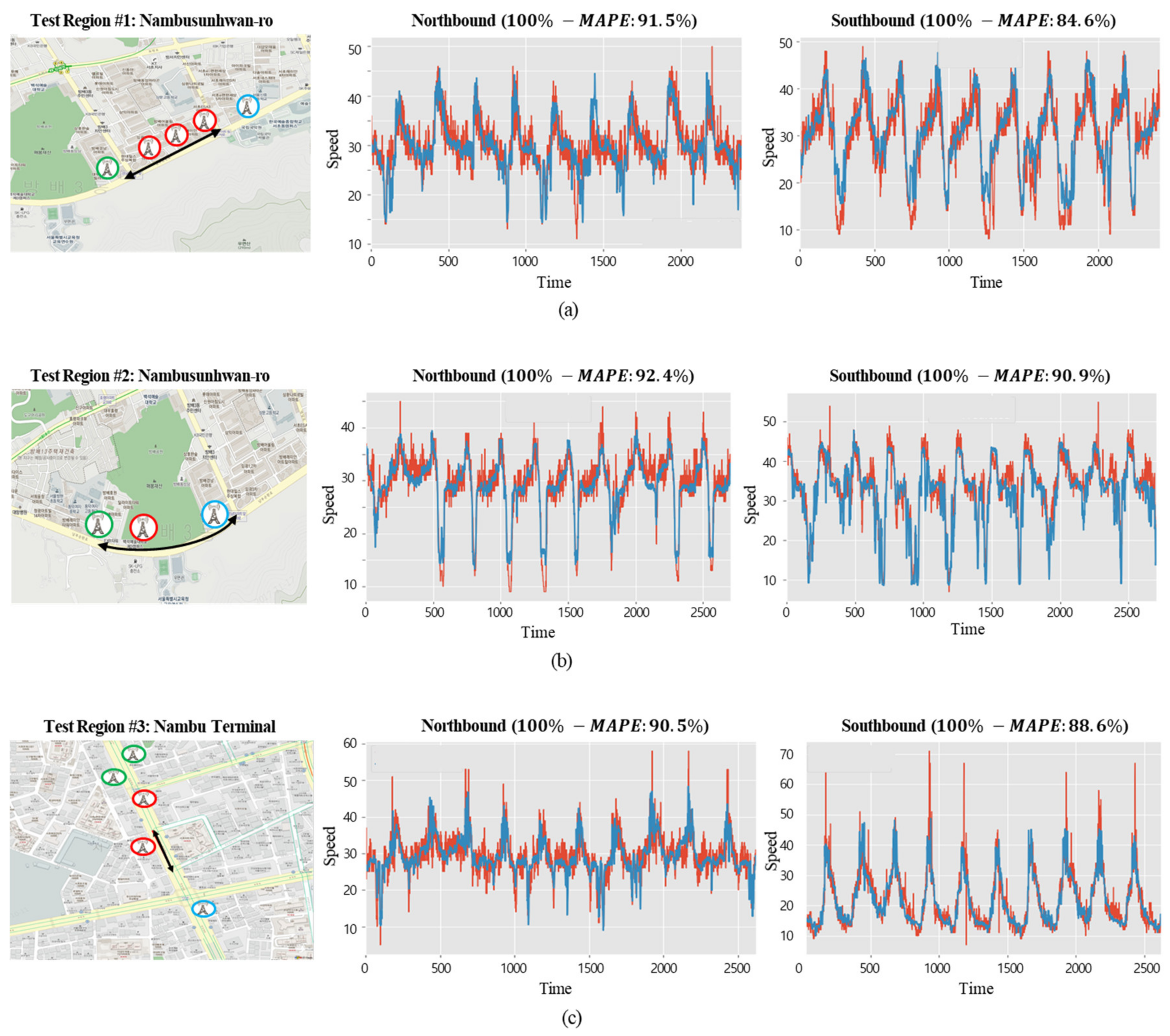
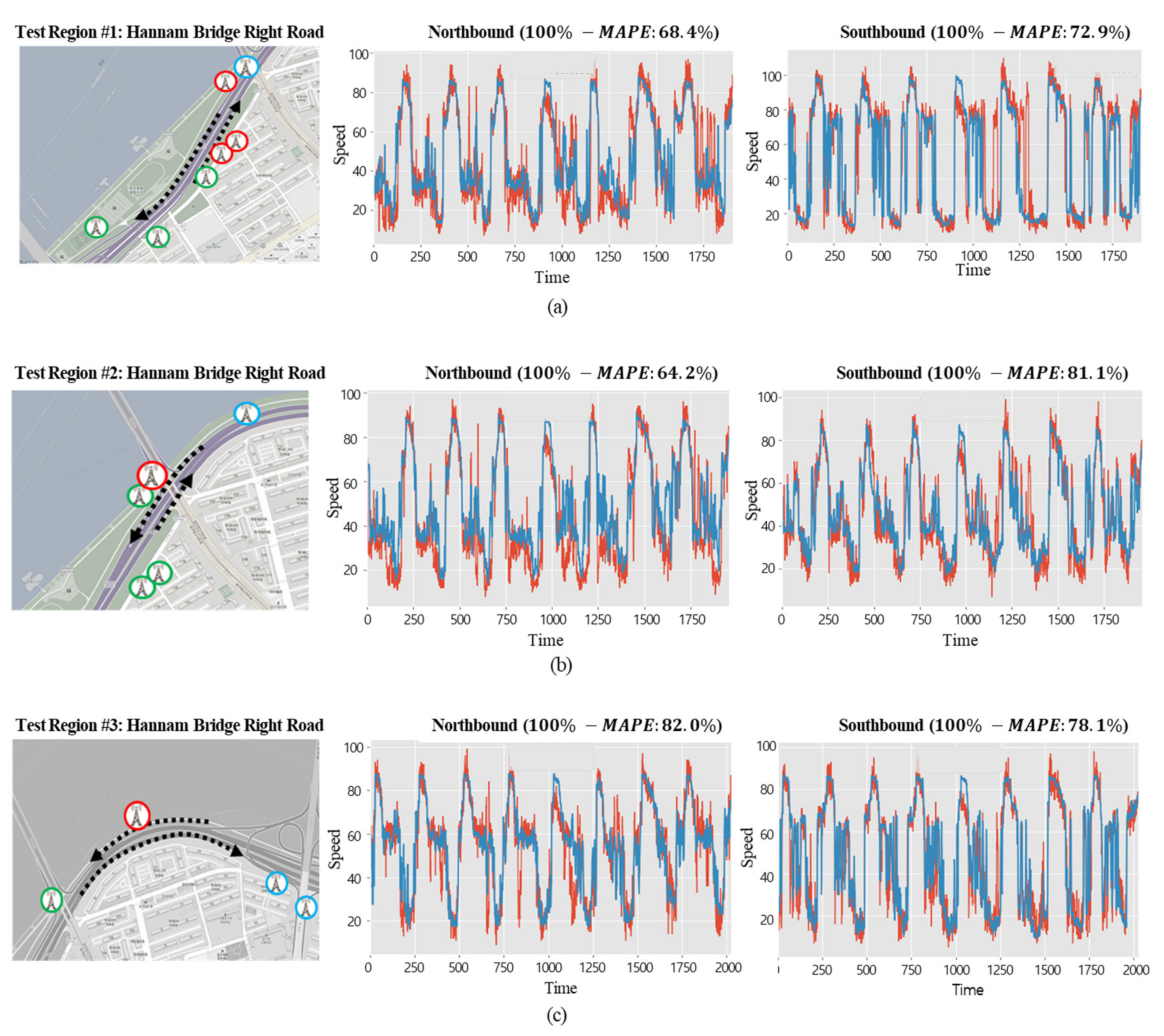
| Column | Description | Remarks |
|---|---|---|
| imsi | IMSI value | User unique identification code |
| mme_cd | MME code value | |
| tmsi | TMSI value | MME code + TMSI |
| start_time | S1 call process start time | |
| end_time | RLC or reset time | |
| setup_time | Attach request to attach complete processing time | |
| cal_time | end_time–start_time | |
| sbt_bts_cd | Alternate base station code | |
| tp | 1: Attach, 2: SRMO, 3: SRMT, 4: TAU, 5: S1HO, 6: Detach, 7: ESRMO, 8: ESRMT | RRC connection detail function type |
| rrc_estab_cause | RRC establish cause value | RRC connection type |
| qci | QCI value | Service priority index |
| reslt | 0: success, 1: fail, 2: reset, 3: warning, 4: ODB | |
| rsn | Defined reject message in NAS PDU | |
| mbl_ip_adr_inet | Mobile IP address | IPv4 or IPv6 |
| enb_ip | eNB IP address | |
| mme_ip | MME IP address | |
| sgw_ip | SGW IP address | |
| tac | TAC | |
| cell_id | Cell ID | |
| pcs_ip | PCS IP | |
| pagng_stat | 1: primary paging, | 1: SP(SMRT_TIME-Paging_TIME) < 3 sec |
| 2: secondary paging, | 2: 3 sec ≤ SP < 6 sec | |
| 3: tertiary paging, | 3: 6 sec ≤ SP < 10 sec | |
| 4: etc. | 4: 10 sec ≤ SP |
| RRC Connection Type (S1AP-“rrc_estab_cause”) | Connection Detail Function Type (S1AP-“tp”) |
|---|---|
| Mobile originating signaling (when the terminal wakes up for signal processing) | Attach: Initial access to MME TAU: Update location when TA changes Detach |
| Mobile originating data (when the terminal wakes up for data transmission) | SMRO: When a data service is requested E-SMRO |
| Mobile termination access (when the terminal wakes up due to an incoming packet) | SMRT E-SMRT |
| QCI | Resource Type | Priority | Packet Delay Budget (ms) | Packet Error Loss Rate | Example Services |
|---|---|---|---|---|---|
| 1 | GBR | 2 | 100 | 10−2 | Conversational voice |
| 2 | GBR | 4 | 150 | 10−3 | Conversational video (live streaming) |
| 3 | GBR | 3 | 50 | 10−3 | Real-time gaming |
| 4 | GBR | 5 | 300 | 10−6 | Non-conversational video (buffered streaming) |
| 5 | Non-GBR | 1 | 100 | 10−6 | IMS signaling |
| 6 | Non-GBR | 6 | 300 | 10−6 | Video (buffered streaming) |
| 7 | Non-GBR | 7 | 100 | 10−3 | Voice, video (live streaming), interactive gaming |
| 8 | Non-GBR | 8 | 300 | 10−6 | TCP-based (WWW, email, FTP); privileged subscriber |
| 9 | Non-GBR | 9 | 300 | 10−6 | TCP-based (WWW, email, FTP); non-privileged subscriber |
© 2019 by the authors. Licensee MDPI, Basel, Switzerland. This article is an open access article distributed under the terms and conditions of the Creative Commons Attribution (CC BY) license (http://creativecommons.org/licenses/by/4.0/).
Share and Cite
Ji, B.; Hong, E.J. Deep-Learning-Based Real-Time Road Traffic Prediction Using Long-Term Evolution Access Data. Sensors 2019, 19, 5327. https://doi.org/10.3390/s19235327
Ji B, Hong EJ. Deep-Learning-Based Real-Time Road Traffic Prediction Using Long-Term Evolution Access Data. Sensors. 2019; 19(23):5327. https://doi.org/10.3390/s19235327
Chicago/Turabian StyleJi, Byoungsuk, and Ellen J. Hong. 2019. "Deep-Learning-Based Real-Time Road Traffic Prediction Using Long-Term Evolution Access Data" Sensors 19, no. 23: 5327. https://doi.org/10.3390/s19235327
APA StyleJi, B., & Hong, E. J. (2019). Deep-Learning-Based Real-Time Road Traffic Prediction Using Long-Term Evolution Access Data. Sensors, 19(23), 5327. https://doi.org/10.3390/s19235327





